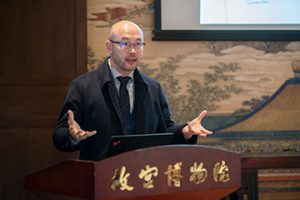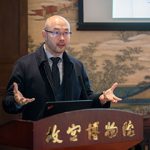
December 20, 2017, by Lindsay Brooke
Protecting art and cultural heritage in the digital age
An expert in digital heritage at the University of Nottingham Ningbo China (UNNC) was at the V&A in London earlier this month to witness the final agreement of a new declaration aimed at re-thinking our approach to reproducing, storing and sharing works of art and cultural heritage in the digital age.
Eugene Ch’ng, Professor of Cultural Computing at UNNC, was also among the experts invited to speak at the V&A ReACH conference, and at the final roundtable to discuss the updating and sharing of best practice in the preservation and reproduction of our cultural heritage. His 20 minute talk, at the Beijing at the Palace Museum, was followed by a Q&A session.
Launched at UNESCO in May 2017, ReACH – Reproduction of Art and Cultural Heritage – is a global initiative spearheaded by the V&A in partnership with the Peri Charitable Foundation. It explores how to re-think our approach to reproducing, storing and sharing works of art and cultural heritage.
The updated convention has been hailed as a 21st century blueprint for navigating the future role of reproductions, available to everyone who has a stake in our cultural heritage.
The history
The first ReACH Convention was held in 1867. It was led by the British civil servant and inventor Sir Henry Cole, the V&A’s founding director. The Convention was charged with “promoting universally reproductions of works of art for the benefit of museums of all countries”, and supported by numerous 19th century crown princes of Europe.
A century and a half later, the new ReACH Convention aims to update Henry Cole’s original vision for the digital age.
The round table discussions helped shape the new declaration which was finalised at the V&A on 8 December.
Confronting the digital age
Professor Ch’ng, Director of the NVIDIA Joint-Lab on Mixed Reality at UNNC, said: “The 21st century poses particular challenges. Unlike plaster casts, electrotypes and analogue photographs used 150 years ago, digital technology has brought about benefits as well as challenges to the art and cultural heritage community. We are not dealing with just the sustainable production, storage and sharing of files as single objects, we are dealing with the complexity of entire systems used for executing ‘Works’ such as the use of virtual reality technology for cultural heritage.”
Use #ReACHdialogue to join the discussion.
More information is available from Professor Eugene Ch’ng, University of Nottingham Ningbo China on 0086 574 8818 3049, engine.chng@nottingham.edu.cn.
No comments yet, fill out a comment to be the first






Leave a Reply